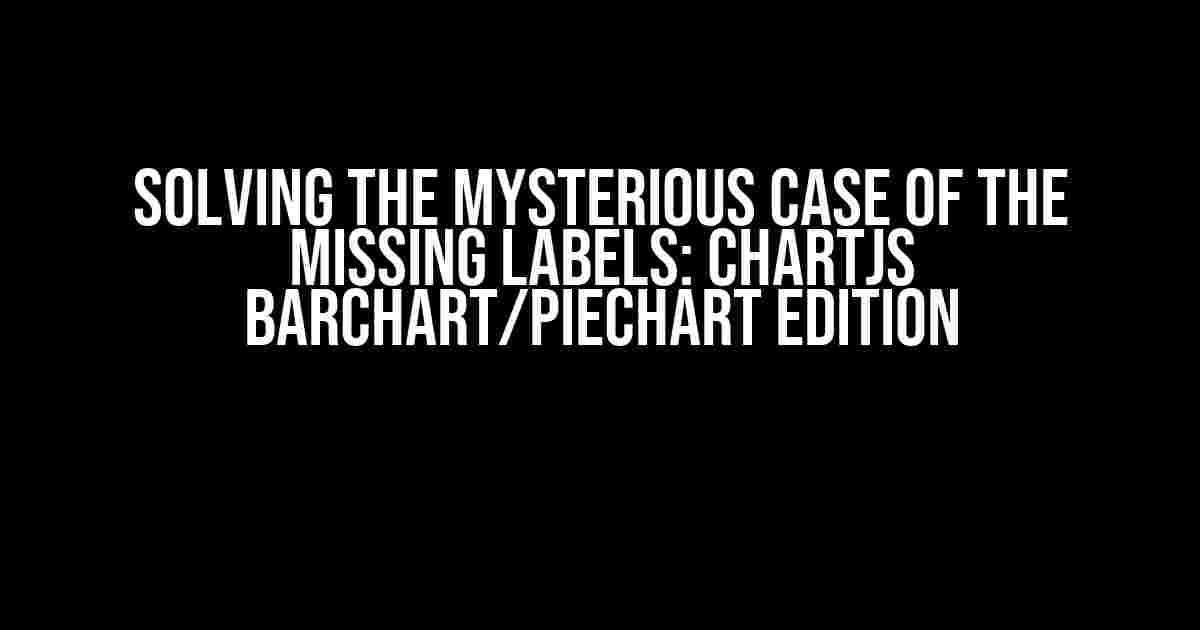Are you tired of staring at a beautifully crafted ChartJS barchart or piechart, only to realize that the labels are nowhere to be found? You’re not alone! In this article, we’ll dive into the most common reasons why your labels might be missing and provide you with step-by-step solutions to get them back.
The Usual Suspects: Common Causes of Missing Labels
Before we dive into the solutions, let’s take a look at the usual suspects behind the missing labels:
- Incorrect chart configuration
- Insufficient data or incorrect data formatting
- Overlapping labels
- Incompatible plugin versions
- Buggy browser behavior
Chart Configuration: The Prime Suspect
More often than not, the culprit behind the missing labels is an incorrect chart configuration. Let’s take a closer look at the most critical settings:
scales and ticks
When it comes to labels, the scales and ticks configurations play a vital role. Make sure you’ve got the following set up correctly:
scales: {
y: {
ticks: {
beginAtZero: true,
font: {
size: 12
}
}
}
}
In the above example, we’re setting the `beginAtZero` property to `true` to ensure the y-axis starts from 0, and the `font` property to define the font size and style for the labels.
plugins and layout
Next, let’s take a look at the plugins and layout configurations:
plugins: [
{
id: 'labels',
afterDraw: (chart) => {
chart.data.datasets.forEach((dataset) => {
dataset.data.forEach((dataPoint, index) => {
const meta = chart.getDatasetMeta(dataset.index);
const { ctx } = chart;
const labelWidth = ctx.measureText(dataPoint.label).width;
const x = meta.xScale Padding + labelWidth / 2;
const y = meta.yScale Padding + 20;
ctx.fillStyle = 'black';
ctx.textAlign = 'center';
ctx.textBaseline = 'middle';
ctx.font = '12px Arial';
ctx.fillText(dataPoint.label, x, y);
});
});
}
}
],
layout: {
padding: 10
}
In the above example, we’re using the `plugins` property to define a custom plugin that will draw the labels manually. We’re also setting the `layout` property to define the padding between the chart and the container.
Data Formatting: The Silent Killer
Incorrect data formatting can also lead to missing labels. Make sure your data is formatted correctly:
data: [{
label: 'Dataset 1',
data: [10, 20, 30, 40, 50],
borderColor: 'rgba(255, 99, 132, 0.2)',
backgroundColor: 'rgba(255, 99, 132, 0.2)',
borderWidth: 1
}, {
label: 'Dataset 2',
data: [50, 40, 30, 20, 10],
borderColor: 'rgba(54, 162, 235, 0.2)',
backgroundColor: 'rgba(54, 162, 235, 0.2)',
borderWidth: 1
}]
In the above example, we’re defining two datasets, each with a `label` property that will be used as the label for the dataset.
Overlapping Labels: The ChartJS Default
By default, ChartJS will not display labels if they overlap. To avoid this, you can use the following trick:
options: {
plugins: {
labels: {
display: (context) => {
return context.dataIndex % 2 === 0;
}
}
}
}
In the above example, we’re using a custom label display function that will only display every other label, effectively avoiding overlapping labels.
Incompatible Plugin Versions: The Sneaky Culprit
Incompatible plugin versions can also cause issues with missing labels. Make sure you’re using the latest compatible versions of ChartJS and its plugins:
In the above example, we’re using the latest compatible versions of ChartJS and the chartjs-plugin-datalabels plugin.
Buggy Browser Behavior: The Wild Card
Sometimes, buggy browser behavior can cause issues with missing labels. Try the following:
- Check for browser updates and ensure you’re running the latest version.
- Try a different browser to see if the issue persists.
- Clear your browser cache and try again.
Solution Checklist
Before we conclude, let’s go through a quick checklist to ensure we’ve covered all the bases:
| Chart Configuration | Data Formatting | Overlapping Labels | Incompatible Plugin Versions | Buggy Browser Behavior |
|---|---|---|---|---|
| ✓ | ✓ | ✓ | ✓ | ✓ |
If you’ve checked all the boxes, congratulations! You should now have a beautifully crafted ChartJS barchart or piechart with labels that are proudly displayed.
Conclusion
Mysterious missing labels can be frustrating, but with this comprehensive guide, you should be well-equipped to troubleshoot and resolve the issue. Remember to double-check your chart configuration, data formatting, and plugin versions. And if all else fails, try a different browser or clear your cache.
Happy charting, and may your labels always be visible!
Frequently Asked Question
Stuck with ChartJS barchart/piechart not showing labels? Don’t worry, we’ve got you covered! Here are some frequently asked questions that might just solve your problem.
Why are my ChartJS labels not showing up?
One possible reason is that you haven’t specified the `label` property in your dataset. Make sure to include `label: ‘Your Label’` in your dataset array. Also, double-check that you haven’t overridden the default label configuration by setting `options.scales.y-axis.display` or `options.scales.x-axis.display` to `false`.
I’ve added labels, but they’re still not visible. What’s going on?
Another common issue is that the label text color is the same as the background color, making it invisible. Try changing the `label` font color using `options.plugins.datalabels.color` or `options.scales.y-axis.ticks.fontColor`. You can also try setting a background color for the labels using `options.plugins.datalabels.backgroundColor`.
My labels are too long and getting cut off. How can I fix this?
To prevent label truncation, you can increase the `options.scales.y-axis.ticks.maxRotation` value to allow for longer labels. Alternatively, you can set `options.scales.y-axis.ticks.callback` to a function that returns a shortened version of the label text.
I’m using a pie chart, and my labels are not showing up. Why?
For pie charts, you need to enable the `options.plugins.datalabels` plugin and set `options.plugins.datalabels.display` to `true`. You can also customize the appearance of the labels using `options.plugins.datalabels.anchor`, `options.plugins.datalabels.align`, and other properties.
I’ve tried everything, but my labels still aren’t showing up. What can I do?
If none of the above solutions work, try checking the ChartJS version you’re using. Make sure you’re running the latest version, as older versions might have bugs or limitations that affect label display. You can also search for similar issues on GitHub or Stack Overflow, or reach out to the ChartJS community for further assistance.
